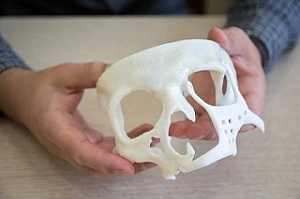Scientists at TSU and the Institute of Strength Physics and Materials Science of Siberian Branch of Russian Academy of Sciences (ISPMS SB RAS) will develop a new complex programme for the technological platform Medicine of the Future. Such a decision was made at the forum "Army-2017", which held a roundtable on additive technologies in medicine whose participants discussed two key topics: bioprinting tissues and organs and new materials for traumatology and orthopedics. To ensure a breakthrough in these areas, civil and military research centres decided to act within the framework of a joint project - a full-cycle programme.
The roundtable participants shared the latest developments in creating new materials for the restoration of human biological tissues. ISPMS SB RAS and TSU showed colleagues implants from nanoceramics, the result of joint work. They have already begun to be used in Russian medicine. In August 2017, Tomsk specialists at the Tomsk National Research Medical Centre conducted an operation to close a defect of the patient's bone tissue with the help of such an implant, for the first time in the country.
- Many participants of the forum had interesting results, - says Sergey Psakhie, director of the ISPMS SB RAS, professor of the TSU Faculty of Physics and Engineering. But these are still separate achievements. To ensure a large-scale breakthrough in the development of materials from which it will be possible to create a replacement for biological tissues and organs, we need to unite.
The Siberian scientists made the first step in this direction in 2016 when, on the initiative of TSU and ISPMS SB RAS, a network centre for reconstruction of craniofacial defects was created. The consortium also included the Tomsk Research Institute of Oncology, Novosibirsk Research Institute of Traumatology and Orthopedics, and Center of New Medical Technologies (Novosibirsk).
Now not only Siberians but scientists from all over Russia intend to unite for the development of medical additive technologies. A number of well-known scientific centres and clinics announced their readiness to participate in the new programme of the technological platform "Medicine of the Future", among them the S.M. Kirov Military Medical Academy, the State Scientific Research Testing Institute of Military Medicine of the Ministry of Defense of the Russian Federation, the Scientific Research Institute of Neurosurgery named after N.N. Burdenko, and other scientific centres. The programme will be prepared by the Institute of Semiconductor Physics of the SB RAS and Tomsk State University. They plan to formulate it by the end of 2017.
- 3D printing in biology and medicine is something the whole world is now working on, says Sergey Psakhie. - The use of additive technologies in medicine opens up completely new opportunities for patients. It is one thing when a prosthesis made according to a template is used and the patient is adjusted to it, and quite another when the joint or other lost fragment is replaced with a personal design that the body will perceive as native.

